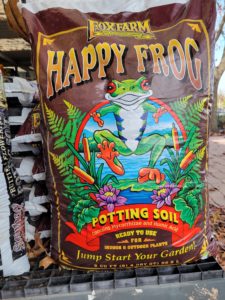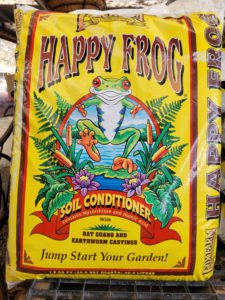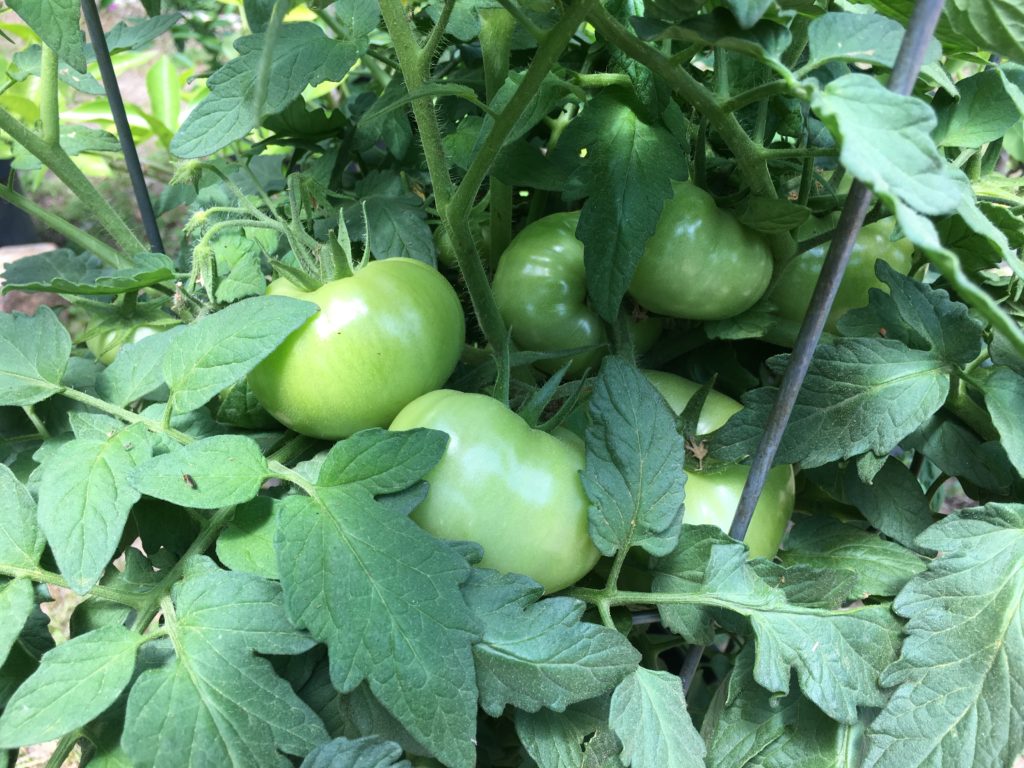Tomato Tips
Timing: Plant as early as possible in Central Texas. Buy your transplants in February and transplant them to 1-gallon pots which you can move in and out according to the temperature. Tomatoes will not do well below 55 degrees but can be set out in the sun during the warmer days until mid-March, when they can be planted directly into the garden. Your plants will likely have flowers and fruit on them when you set them out!
Container or In-ground: Containers should be a minimum of 15 gallon, with whiskey barrel size preferred. Happy Frog potting soil may be mixed half and half with Happy Frog Soil Conditioner to stretch the amount used. In-ground gardens should be fertile, organic soil mixed with compost. Mulch will help conserve moisture and keep weeds at bay.


Soil pH: tomatoes do best in a pH of 6.5-6.7. Pine compost (Happy Frog Soil Conditioner) will help lower pH in our alkaline soils. Avoid barnyard manure, which usually has a high pH and is quite high in Phosphorous as well.
Row Cover: Once transplants have been set out, use row cover around the tomato cage to “harden off” the tender plants. Row cover may also be used to exclude insects and give frost protection.
Pollination: Tomatoes are wind pollinated. Their pollen is non-viable when nighttime temps are above 72 degrees or below 55 degrees, and daytime temps are over 85 degrees. If planted too late, fruit will not set. This is the reason that we get them started in pots early, so that we can control the temperature and get a jump-start on the season.
Determinate or Indeterminate?
Since “determinate” tomatoes flower and produce fruit, grow to a determined height and then stop growing, they are good candidates for growing in pots. Staking will be minimal, and a large number of tomatoes will be produced at one time, which is good for those who “can” tomatoes, and for fall production of tomatoes where you want them to produce before the cold weather hits.
“Indeterminate” tomatoes grow and produce flowers and fruit, grow more and produce more flowers and fruit and the plants get quite large, requiring a sturdy tomato cage. These are mostly, but not all, the smaller tomatoes, and the harvest time will be spread out a bit longer than “determinate” types.
Insects and Disease:
Once your tomatoes are growing well, and reach about 2 ½’ tall, begin removing the bottom leaves up about one foot from the ground. This goes a long way in preventing fungal spores from splashing up on the bottom leaves and infecting the plant.
If you do find leaf spotting which looks like disease, trim them off and bring them to the nursery in a plastic bag for diagnosis.
Spider mites can be prevented by spraying weekly with a liquid Seaweed solution. Be sure to get the undersides of the leaves.
Water sprays directed at the undersides of the leaves can be effective at dislodging the mites.
Oil sprays, when at the correct temperature are very effective. Oil and Neem should not be used at temps above 85°F.
Spinosad or Spinosad Soap products may also be effective.
Rotate all members of the tomato family to a different area each year to avoid repeat of insects and diseases from last year. This family includes potatoes, peppers and eggplants.
Leaf footed bug
If leaf-footed bugs invade your garden, learn what the eggs and nymphs (babies) look like. They can be picked off and put in a can of soapy water or sprayed with a spinosad/soap solution. Once they mature, the best way to rid your tomatoes of them is to purchase a cordless handvac-there are ones your rechargeable drill batteries will fit on-and go out at night with a flashlight and vacuum them up! Dump them in a bucket of soapy water before they fly away! These are the insects which “sting” the fruit, leaving a tough whitish spot under the skin.
You WILL want to control them!
Leaf footed bug damage to tomatoes
Blossom end rot is a physiological disease of tomatoes. It is often said to be caused by a calcium deficiency, and it is, but not always because calcium is lacking in the soil. When soil moisture fluctuates from wet to dry, tiny hair roots die. Since the hair roots absorb much of the water and nutrients for the plant, uptake is compromised. The part of the plant furthest from the root system is the fruit, so when calcium is not transported to the end of the fruit, it shows calcium deficiency symptoms, which is blossom end rot
Tomato hornworms look like a giant green or brown worm from outer space. They have the characteristic “horn” at the tail end of their body. These behemoths can consume an enormous amount of foliage overnight.
Weekly sprays of Bt or Spinosad will help prevent damage.
If your plants are stunted and have pale yellow foliage, you might have root knot nematodes. These microscopic organisms cause swelling on the roots of the plants. Take a good look when you pull up the plants and if the roots look like this, you have root knot nematodes. Planting a “catch crop” of Elbon Rye in the winter, or French Marigolds in the summer, then tilling it in will lessen the numbers of this pest. There is no appropriate chemical control for vegetable gardens.
Cracks in tomatoes occur with fluctuations in soil moisture, rapid growth after fertilization or are just common in some varieties such as Celebrity.
Crop Rotation: Since disease can overwinter in the soil, it is important to NOT plant any member of the tomato family in the same area two years in a row.
Crops in the Solanaceae family include tomatoes, potatoes, peppers, and eggplant.
Fertilization:
Water -in new transplants with a soluble fertilizer mixed at half-strength.
Organic fertilizers such as Happy Frog Jump Start with beneficial microorganisms may also be incorporated at the time of planting. Happy Frog Tomato and Vegetable food should be applied monthly as a top dress, and weekly applications of Fox Farm ‘Kelp Me Kelp You’ Liquid Seaweed or Fox Farm ‘Wholly Mackerel’ Fish Fertilizer as a foliar spray will keep the nutrients available.
Watering:
Avoid overhead watering if possible, as it contributes to conditions that are favorable to disease. Drip irrigation is recommended and should be run long enough to percolate at least 8” each watering. Keeping the soil evenly moist will avoid many issues with tomatoes. Using a 2” layer of mulch will keep weeds down and keep the soil from drying out too much.
Allowing the soil to go through wet-dry cycles will result in drought stress. As mentioned before, this shows up as Blossom End Rot on tomatoes. Because there was a period of drought stress, calcium from the soil was not able to be translocated to the farthest location on the tomato fruit-the blossom end-at the bottom of the tomato. While this physiological disease can be due to calcium deficiency in the soil, it is not common in soils in Central Texas. Plants grown in potting soil in pots should receive adequate amounts of calcium in fertilizer.
Note: Even if the calcium is in the soil, if the plant is drought stressed, Blossom End Rot will occur.
